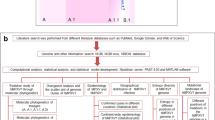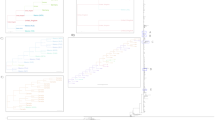Abstract
Monkeypox virus is a member of the family Poxviridae, as are variola virus and vaccinia virus. It has a linear double-strand DNA genome approximately 197 kb long, containing ~190 non-overlapping ORFs. Comparison of members of the Central and West African clades shows the presence of unique genes that are associated with different disease presentations, depending on the strain. The last smallpox vaccination efforts ended in the mid-1980s, and there is concern about the recent spread of human monkeypox disease around the world. Almost 87,000 human monkeypox cases have been diagnosed in the world, of which more than 10,900 were in Brazil. The aim of this study was to evaluate the epidemiology and molecular evolution of hMpxV. From computational biology analysis of 640 hMpxV genomes from 1962 to 2022, synteny breaks and gene conservation were observed between Central and West clade genomes, and strains belonged with the 2022 outbreak assigned to the West African clade. Evidence was found for diversifying selective pressure at specific sites within protein coding sequences, acting on immunomodulatory processes. The existence of different sites under diversifying and purifying selection in paralog genes indicates adaptive mechanisms underlying the host-pathogen interaction of monkeypox virus in humans.






Similar content being viewed by others
Data availability
Full tables acknowledging the authors and corresponding labs submitting sequencing data used in this study can be found in Online Resource 8. Additional information used and/or analyzed during the current study is available from the corresponding author on reasonable request.
References
Aksamentov I, Roemer C, Hodcroft E, Neher R (2021) Nextclade: Clade assignment, mutation calling and quality control for viral genomes. J Open Source Softw 6(67):3773. https://doi.org/10.21105/joss.03773
Bahar MW, Graham SC, Chen RA-J, Cooray S, Smith GL, Stuart DI, Grimes JM (2011) How vaccinia virus has evolved to subvert the host immune response. J Struct Biol 175(2):127–134. https://doi.org/10.1016/j.jsb.2011.03.010
Brennan G, Stoian AMM, Yu H, Rahman MJ, Banerjee S, Stroup JN, Park C, Tazi L, Rothenburg S (2023) Molecular mechanisms of poxvirus evolution. MBio 14(1):e01526-e1622. https://doi.org/10.1128/mbio.01526-22
Darling ACE, Mau B, Blattner FR, Perna NT (2004) Mauve: multiple alignment of conserved genomic sequence with rearrangements. Genome Res 14(7):1394–1403. https://doi.org/10.1101/gr.2289704
Dumonteil E, Herrera C, Sabino-Santos G (2023) Monkeypox virus evolution before 2022 outbreak. Emerg Infect Dis 29(2):451–453. https://doi.org/10.3201/eid2902.220962
Elde NC, Child SJ, Eickbush MT, Kitzman JO, Rogers KS, Shendure J, Geballe AP, Malik HS (2012) Poxviruses deploy genomic accordions to adapt rapidly against host antiviral defenses. Cell 150(4):831–841. https://doi.org/10.1016/j.cell.2012.05.049
Estep RD, Messaoudi I, O’Connor MA, Li H, Sprague J, Barron A, Engelmann F, Yen B, Powers MF, Jones JM, Robinson BA, Orzechowska BU, Manoharan M, Legasse A, Planer S, Wilk J, Axthelm MK, Wong SW (2011) Deletion of the monkeypox virus inhibitor of complement enzymes locus impacts the adaptive immune response to monkeypox virus in a nonhuman primate model of infection. J Virol 85:9527–9542. https://doi.org/10.1128/JVI.00199-11
Emms DM, Kelly S (2019) OrthoFinder: phylogenetic orthology inference for comparative genomics. Genome Biol. https://doi.org/10.1186/s13059-019-1832-y
Finkel Y, Stern-Ginossar N, Schwartz M (2018) Viral short ORFs and their possible functions. Proteomics 18(10):1700255. https://doi.org/10.1002/pmic.201700255
Gotz S, Garcia-Gomez JM, Terol J, Williams TD, Nagaraj SH, Nueda MJ, Robles M, Talon M, Dopazo J, Conesa A (2008) High-throughput functional annotation and data mining with the Blast2GO suite. Nucleic Acids Res 36(10):3420–3435. https://doi.org/10.1093/nar/gkn176
Guan H, Gul I, Xiao C, Ma S, Liang Y, Yu D, Liu Y, Liu H, Zhang CY, Li J, Qin P (2023) Emergence, phylogeography, and adaptive evolution of mpox virus. New Microbes New Infect 52:101102. https://doi.org/10.1016/j.nmni.2023.101102
Gubser C, Hué S, Kellam P, Smith GL (2004) Poxvirus genomes: a phylogenetic analysis. J Gen Virol 85(1):105–117. https://doi.org/10.1099/vir.0.19565-0
Hammarlund E, Lewis MW, Carter SV, Amanna I, Hansen SG, Strelow LI, Wong SW, Yoshihara P, Hanifin JM, Slifka MK (2005) Multiple diagnostic techniques identify previously vaccinated individuals with protective immunity against monkeypox. Nat Med 11(9):1005–1011. https://doi.org/10.1038/nm1273
Hendrickson RC, Wang C, Hatcher EL, Lefkowitz EJ (2010) Orthopoxvirus genome evolution: the role of gene loss. Viruses 2(9):1933–1967. https://doi.org/10.3390/v2091933
Hudson PN, Self J, Weiss S, Braden Z, Xiao Y, Girgis NM, Emerson G, Hughes C, Sammons SA, Isaacs SN, Damon IK, Olson VA (2012) Elucidating the role of the complement control protein in monkeypox pathogenicity. PLoS ONE 7:e35086. https://doi.org/10.1371/journal.pone.0035086
Isidro J, Borges V, Pinto M, Sobral D, Santos JD, Nunes A, Mixão V, Ferreira R, Santos D, Duarte S, Vieira L, Borrego MJ, Núncio S, de Carvalho IL, Pelerito A, Cordeiro R, Gomes JP (2022) Phylogenomic characterization and signs of microevolution in the 2022 multi-country outbreak of monkeypox virus. Nat Med 28:1569–1572. https://doi.org/10.1038/s41591-022-01907-y
Kalyaanamoorthy S, Minh BQ, Wong TKF, von Haeseler A, Jermiin LS (2017) ModelFinder: fast model selection for accurate phylogenetic estimates. Nat Methods 14(6):587–589. https://doi.org/10.1038/nmeth.4285
Kochneva G, Kolosova I, Maksyutova T, Ryabchikova E, Shchelkunov S (2005) Effects of deletions of kelch-like genes on cowpox virus biological properties. Adv Virol 150(9):1857–1870. https://doi.org/10.1007/s00705-005-0530-0
Kosakovsky Pond SL, Frost SDW (2005) Not so different after all: a comparison of methods for detecting amino acid sites under selection. Mol Biol Evol 22(5):1208–1222. https://doi.org/10.1093/molbev/msi105
Kugelman JR, Johnston SC, Mulembakani PM, Kisalu N, Lee MS, Koroleva G, McCarthy SE, Gestole MC, Wolfe ND, Fair JN, Schneider BS, Wright LL, Huggins J, Whitehouse CA, Wemakoy EO, Muyembe-Tamfum JJ, Hensley LE, Palacios GF, Rimoin AW (2014) Genomic variability of monkeypox virus among humans, Democratic Republic of the Congo. Emerg Infect Dis. https://doi.org/10.3201/eid2002.130118
Kumar Roshan Nagar S, Haider S, Sood U, Ponnusamy K, Dhingra GG, Anand S, Dua A, Singh M, Kumar Roushan Sengar M, Singh IK, Lal R (2023) Monkeypox virus: phylogenomics, host–pathogen interactome and mutational cascade. Microb Genom 9:000987. https://doi.org/10.1099/mgen.0.000987
Lant S, Maluquer de Motes C (2021) Poxvirus interactions with the host ubiquitin system. Pathogens 10(8):1034. https://doi.org/10.3390/pathogens10081034
Lee Y-R, Yuan W-C, Ho H-C, Chen C-H, Shih H-M, Chen R-H (2010) The Cullin 3 substrate adaptor KLHL20 mediates DAPK ubiquitination to control interferon responses. EMBO J 29(10):1748–1761. https://doi.org/10.1038/emboj.2010.62
Likos AM, Sammons SA, Olson VA, Frace AM, Li Y, Olsen-Rasmussen M, Davidson W, Galloway R, Khristova ML, Reynolds MG, Zhao H, Carroll DS, Curns A, Formenty P, Esposito JJ, Regnery RL, Damon IK (2005) A tale of two clades: monkeypox viruses. J Gen Virol 86(10):2661–2672. https://doi.org/10.1099/vir.0.81215-0
Mosavi LK, Cammett TJ, Desrosiers DC, Peng Z (2004) The ankyrin repeat as molecular architecture for protein recognition. Protein Sci 13(6):1435–1448. https://doi.org/10.1110/ps.03554604
Murrell B, Moola S, Mabona A, Weighill T, Sheward D, Kosakovsky Pond SL, Scheffler K (2013) FUBAR: a fast, unconstrained bayesian AppRoximation for inferring selection. Mol Biol Evol 30(5):1196–1205. https://doi.org/10.1093/molbev/mst030
Nguyen L-T, Schmidt HA, von Haeseler A, Minh BQ (2014) IQ-TREE: a fast and effective stochastic algorithm for estimating maximum-likelihood phylogenies. Mol Biol Evol 32(1):268–274. https://doi.org/10.1093/molbev/msu300
Pallett MA, Ren H, Zhang R-Y, Scutts SR, Gonzalez L, Zhu Z, Maluquer de Motes C, Smith GL (2019) Vaccinia virus BBK E3 ligase adaptor A55 targets importin-dependent NF-κB activation and inhibits CD8 + T-cell memory. J Virol. https://doi.org/10.1128/jvi.00051-19
Pueyo JI, Magny EG, Couso JP (2016) New peptides under the s(ORF)ace of the genome. Trends Biochem Sci 41(8):665–678. https://doi.org/10.1016/j.tibs.2016.05.003
Rambaut A, Lam TT, Max Carvalho L, Pybus OG (2016) Exploring the temporal structure of heterochronous sequences using TempEst (formerly Path-O-Gen). Virus Evol 2(1):vwe007. https://doi.org/10.1093/ve/vew007
Shchelkunov SN, Blinov VM, Sandakhchiev LS (1993) Ankyrin-like proteins of variola and vaccinia viruses. FEBS Lett 319(1–2):163–165. https://doi.org/10.1016/0014-5793(93)80059-4
Supek F, Bošnjak M, Škunca N, Šmuc T (2011) REVIGO summarizes and visualizes long lists of gene ontology terms. PLoS ONE 6(7):e21800. https://doi.org/10.1371/journal.pone.0021800
Tennessen JA (2008) Positive selection drives a correlation between non-synonymous/synonymous divergence and functional divergence. Bioinformatics 24(12):1421–1425. https://doi.org/10.1093/bioinformatics/btn205
Wang L, Shang J, Weng S, Aliyari SR, Ji C, Cheng G, Wu A (2022) Genomic annotation and molecular evolution of monkeypox virus outbreak in 2022. J Med Virol 2022:e28036. https://doi.org/10.1002/jmv.28036
Weaver JR, Isaacs SN (2008) Monkeypox virus and insights into its immunomodulatory proteins. Immunol Rev 225(1):96–113. https://doi.org/10.1111/j.1600-065x.2008.00691.x
Werden SJ, Rahman MM, McFadden G (2008) Chapter 3 poxvirus host range genes. In: Advances in virus research. Elsevier, pp 135–171. https://doi.org/10.1016/S0065-3527(08)00003-1
Yang Z (2007) PAML 4: phylogenetic analysis by maximum likelihood. Mol Biol Evol 24(8):1586–1591. https://doi.org/10.1093/molbev/msm088
Yang Z, Nielsen R, Goldman N, Pedersen A-MK (2000) Codon-Substitution models for heterogeneous selection pressure at amino acid sites. Genetics 155(1):431–449. https://doi.org/10.1093/genetics/155.1.431
Yu X, Shi H, Cheng G (2023) Mpox virus: its molecular evolution and potential impact on viral epidemiology. Viruses 15(4):995. https://doi.org/10.3390/v15040995
Zhan X-Y, Zha G-F, He Y (2023) Evolutionary dissection of monkeypox virus: positive Darwinian selection drives the adaptation of virus–host interaction proteins. Front Cell Infect Microbiol. https://doi.org/10.3389/fcimb.2022.1083234
Acknowledgements
We would like to thank Dr. Mark Thompson for reviewing the English writing.
Funding
This research did not receive any specific grant from funding agencies in the public, commercial, or not-for-profit sectors.
Author information
Authors and Affiliations
Contributions
PAGF and CET conceived the idea, designed the study, and performed all data analysis, investigation, and original draft preparation. PAGF, CET, and RAPC performed the manuscript review and editing. All authors have read and approved the manuscript.
Corresponding author
Ethics declarations
Conflict of interest
The authors have no relevant financial or non-financial interests to disclose.
Additional information
Handling Editor: William G Dundon.
Publisher's Note
Springer Nature remains neutral with regard to jurisdictional claims in published maps and institutional affiliations.
Supplementary Information
Below is the link to the electronic supplementary material.
705_2023_5904_MOESM1_ESM.pdf
Online Resource 1 Genomic alignment between Central African clade sequence DQ011155.1 (human monkeypox virus strain Zaire_1979-005) and West African clade sequence NC_063383.1 (human monkeypox virus strain M5312_HM12_Rivers). Identity indicates synteny conservation between genomic blocks, which are colored in gray (syntenic) or black (non-syntenic). Annotated genes are colored in red and labeled. Predicted ORFs are colored in yellow. Genes with sites under positive selection pressure are highlighted in light red boxes
705_2023_5904_MOESM3_ESM.pdf
Online Resource 3 Gene identification correspondence from sequences with positively selected sites in orthogroups shared between monkeypox virus, vaccinia virus, and variola virus genomes
705_2023_5904_MOESM4_ESM.png
Online Resource 4 Synteny conservation between Central African clade sequence DQ011155.1 (human monkeypox virus strain Zaire_1979-005) and West African clade sequence NC_063383.1 (human monkeypox virus strain M5312_HM12_Rivers) for AAY97205 (A) and AAY97367 (B) sequence regions. Block colors indicate synteny conservation (pink), partial conservation (red), and synteny break (white). White horizontal bars indicate annotated genes. Blue arrows indicate predicted ortholog ORFs
705_2023_5904_MOESM5_ESM.xlsx
Online Resource 5 Sites identified as being under positive and negative selective pressure by the FUBAR and FEL method, respectively, for monkeypox virus genes and their associated biological processes
705_2023_5904_MOESM6_ESM.xlsx
Online Resource 6 Sites identified as being under positive and negative selective pressure for monkeypox virus genes of 2022 outbreak genomes by FUBAR and FEL methods
705_2023_5904_MOESM7_ESM.pdf
Online Resource 7 Maximum-likelihood phylogenetic tree based on 155 concatenated monkeypox virus gene alignments. (A) Partitioned tree. (B) Non-partitioned best-fit tree generated with TempEst software by evaluation of the sequence's temporal signal
Rights and permissions
Springer Nature or its licensor (e.g. a society or other partner) holds exclusive rights to this article under a publishing agreement with the author(s) or other rightsholder(s); author self-archiving of the accepted manuscript version of this article is solely governed by the terms of such publishing agreement and applicable law.
About this article
Cite this article
Ferrareze, P.A.G., Pereira e Costa, R.A. & Thompson, C.E. Genomic characterization and molecular evolution of human monkeypox viruses. Arch Virol 168, 278 (2023). https://doi.org/10.1007/s00705-023-05904-5
Received:
Accepted:
Published:
DOI: https://doi.org/10.1007/s00705-023-05904-5




